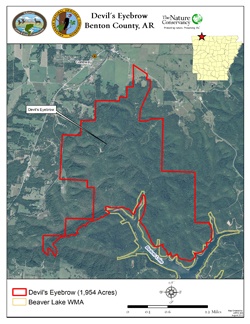The Nature Conservancy Pays $3.91 Million for Beaver Lake Land
by September 20, 2012 8:54 am 476 views

A three-mile stretch of undeveloped Beaver Lake shoreline is part of a 1,954-acre acquisition — purchased for $3.91 million — completed recently by the The Nature Conservancy of Arkansas.
The transaction was done at the request of the Arkansas Natural Heritage Commission, which has received preliminary approval to buy the land from the NCA and establish it as the state’s 71st natural area.
The ANHC will be submitting a request for final approval from Gov. Mike Beebe. Once acquired by the state, the property will be incorporated into the Beaver Lake Wildlife Management Area.
“There are two really great results from this,” said Scott Simon, the state director for the NCA. “The first is that a beautiful area will be open to the public for everyone to enjoy for a variety of issues. The second is this will keep the land natural. That means it helps protect Beaver Lake. It’s a really great example of collaboration for conservation in Arkansas.”
The NCA, an affiliate of the international nonprofit organization Nature Conservancy based in Virginia, bought the property — known as Devil’s Eyebrow — from Guy McCollum and Len Thompson, through their Eagles Bluff LLC.
“I’m not sure who contacted whom first,” said Simon, who said the acquisition process has taken about a year and a half. “But the price became more reasonable and the ANHC asked us to get involved.”
Currently there are 70 natural areas encompassing 58,000 acres owned and managed by the Arkansas Natural Heritage Foundation.
The Nature Conservancy will be selling the property to the state at a discounted rate of $3.52 million. The selling price is about $400,000 less than the buying price due in part to a private donation from the National Fish and Wildlife Foundation, and the Acres for America Program under the umbrella of Wal-Mart Stores Inc. that aided in the acquisition.
“That gift is going to allow the state of Arkansas to buy the land at a discounted price,” Simon said.
The ANHC will use funds from the 1/8th cent conservation tax, and its grand award from the Natural and Cultural Resources Council to acquire its portion of the property this year.
The amount the ANHC will pay is $1,600 per acre up to $3.13 million for the land.
Simon said the Arkansas Game & Fish Commission is considering participating in the acquisition with an undisclosed amount.
The Nature Conservancy will also contribute private funds, Simon said.
The name “Devil’s Eyebrow” is a natural landmark on the western boundary of the tract in a spot along the San Francisco Railroad, according to Theo Whitsell, a botanist with the ANHC.
Whitsell references a 1957 article by Erwin Funk in The Benton County Pioneer (publication of the Benton County Historical Society), which discussed the origin of the name by saying:
“Some two miles north of Garfield the railroad skirts a deep ravine about a quarter of a mile long with a steep rocky wall, cedar covered in the early days, and a favored picnic spot for those who enjoyed a little strenuous climbing and a wonderful view of the country.
“In 1880, when the surveyors were doing their preliminary work on the location of the Frisco Railroad, Archibald ‘Uncle Arch’ Blansett (one of the pioneer settlers in the area) with other neighbors were greatly interested in the proposed route through their neighborhood. Discussing the route with one of the railroad party he is credited with saying: ‘Build a railroad right through these mountains? You can’t do it, man; you can’t do it. You might as well try to build a railroad on the Devil’s eyebrow as to undertake to build one in such a place.’
“The railroaders were so amused by the remark that from then on it was always known, even in Frisco literature, as the ‘Devil’s Eyebrow’. The name still sticks.”
The land is a mixture of limestone glades, oak woodlands, bluffs and forests. It contains several streams, the headwater arm of Indian Creek and Trimble Mountain, with an elevation of 1,720 feet above sea level.
The acreage is also the only confirmed site in Arkansas to contain the rare black maple tree, and is also a large and well-known Bald Eagle winter roost.
